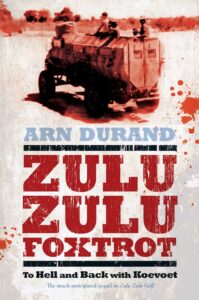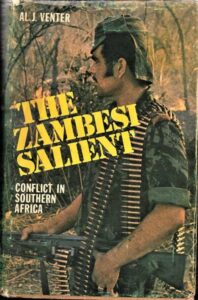Subtitle: The Night Belongs to Us
Summary: ‘Every AK-47 is now firmly trained on the approaching man. Adrenaline pumps through the operators’ veins. They hold their breath, their hearts in their mouths.’ 1 Recce. One of the sharpest, most versatile and deadliest specialist units in the South African Defence Force. These men — superfit and unbelievably tough — were dauntless. Time and again they put their lives on the line in covert operations that were mostly conducted under the cover of night, far behind enemy lines. For decades, the participants have kept silent about these secret missions. Now, for the first time, the Recces’ legendary commanders reveal details about their many politically sensitive operations. The award-winning author Alexander Strachan, himself a former Recce, tells the full story of 1 Recce’s formation, history and role in the Bush War. After years of myth and secrecy, this book provides an inside look at the Recces and the work they did invisibly behind the scenes.
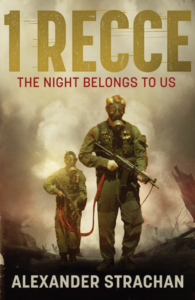
Subtitle: Information not available
Summary: Originally formed in order to lend support to the FNLA and UNITA in the Angolan war, 32 Battalion quickly gained the reputation of being an unconventional, secretive, yet highly effective group. Written by a man who was intimately involved with the unit and served as its Regimental Sergeant Major for two years, the book aims to explode the myths surrounding the legendary 32 and set the record straight. It records how and why 32 Battalion was formed, explores its unique identity forged by the men who fought in it, details the many operations in which they participated, and concludes with its eventual disbandment at the dawn of a new South Africa. What they did, and how they did it, would earn this controversial group official recognition as the best fighting unit in the South African Army since World War II. This book’s unembellished, factual reporting will fill a big gap in the highly popular military genre.
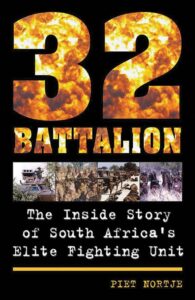
Subtitle: The inside story of a Recce's Special Forces training year
Summary: The South African Special Forces, or Recces, has always been known for their gruelling selection course that pushes soldiers to the ends of their physical and mental limits. Many sign up for it; only a select few ever pass. After passing the selection course, recruits still have to complete an exacting year-long training course before they can join the ranks of this elite unit. In A Breed Apart, former Special Forces operator Johan Raath offers a rare insider’s view on the training he and other young soldiers received in the 1980s. Due to a high demand for these specialist soldiers at the time, he was part of a group that also did their basic training in the Special Forces. The content of each of their courses are described in detail to show the range and the standard of the training they received in, among others, weapons handling, bushcraft/survival, demolitions, urban warfare, as well as seaborne and riverine operations. Their training culminated in a real-life operation on the Border where they saw action for the first time. Much of the training Raath underwent is still part of the present day Special Forces training. Comprehensive and revealing, this book shows why these soldiers truly are a breed apart.
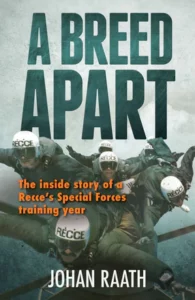
Subtitle: Information not available
Summary: The world has witnessed several battles since the dawn of time. Whether ancient or recent, they all contain a wealth of data useful for life in several circumstances. These battles, which had a significant influence on the life of mankind and defined the course of history, have been the object of study by many scholars. Besides these and other battles framed in the context of great armed conflicts, the world has long recorded the occurrence of small-scale fighting associated with a number of armed conflicts. One must stress low-intensity armed conflicts. Beyond this fact, however, certain successive military fights in the context of such armed conflicts are called battles. This is the case of fights in the armed conflict of Angola, which took place in the period between 1975 and 1976. It is in this scope that the military confrontation in Kifangondo is called a battle. The fighting caused a shock amongst several military forces. Miguel Junior is a general officer of the Angolan Armed Forces and is a military historian. He has published six books and is the co-author and organizer of three other books. He has written several articles on defence, security, and history.
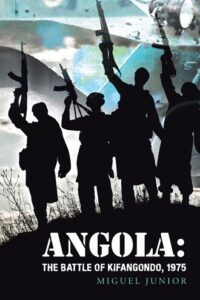
Subtitle: Colonial–Communist Clash, 1961–1974
Summary: When a large group of rebels invaded Angola from a recently independent Congo in 1961, it heralded the opening shots in another African war of independence. Between 1961 and 1974, Portugal faced the extremely ambitious task of conducting three simultaneous counterinsurgency campaigns to preserve its hegemony of Angola, Portuguese Guinea and Mozambique. While other European states were falling over themselves in granting independence to their African possessions, Portugal chose to stay and fight despite the odds against success. That it did so successfully for thirteen years in a distant multi-fronted war remains a remarkable achievement, particularly for a nation of such modest resources. For example, in Angola the Portuguese had a tiny air force of possibly a dozen transport planes, a squadron or two of F-86s and perhaps twenty helicopters: and that in a remote African country twice the size of Texas. Portugal proved that such a war can be won. In Angola victory was complete. However, the political leadership proved weak and irresolute, and this encouraged communist elements within the military to stage a coup in April 1974 and lead a capitulation to the insurgent movements, squandering the hard-won military and social gains and abandoning Portugals African citizens to generations of civil war and destitution.

Subtitle: Soviet Soldiers’ accounts of the Angolan War
Summary: For almost fifteen year South Africa was involved in a civil war in Angola, the so-called Bush War, on behalf of the UNITA faction. The climax of this portrayed conflict was the battle of Cuito Cuanavale, the largest military engagement on African soil since the Second World War. Here South African forces came to blows with Angolan FAPLA troops and their Cuban allies in a battle whose outcome is still hotly debated. Thousands of South African conscripts took part in the Bush War and their stories are beginning to be told. What us much less known is the view from the other side. This book provides, for the first time in English, first-hand, personal accounts of the conflict, leading up to Cuito Cuanavale, as told by Soviet advisers to the Angolan army. Their experience of the war and their views and assessment of their South African enemies as well as their Cuban and Angolan allies will surprise and fascinate South African readers and at the same time offer new insights into the conflict.
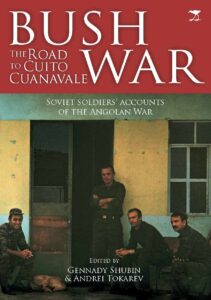
Subtitle: A Trooper's War in the Rhodesian Light Infantry
Summary: Fire Force is the account of Chris Cocks’s service in 3 Commando, The Rhodesian Light Infantry ( RLI), during Zimbabwe’s civil war of the 1970s—a war that came to be known, almost innocuously, as ‘the bush war’. Fire Force, a tactic of total airborne/airmobile envelopment, was developed by the RLI, and became the principal strike weapon of the beleaguered Rhodesian forces in their struggle against the tide of the communist-trained and -equipped ZANLA and ZIPRA guerrillas. “Like Reitz’s work, Commando: A Boer Journal of the Boer War, Fire Force, by first-time author Chris Cocks, is a personal account of close-quarter warfare. It is a unique, compelling, sometimes brutal account of a young conscript’s three years of service in the elite Rhodesian Light Infantry … Cocks’s work is one of the very few books which adequately describes the horrors of war in Africa … Fire Force is the best book on the Rhodesian War that I have read.” Southern African Review of Books “Fire Force will be to the Rhodesian War what Remarque’s All Quiet on The Western Front was to World War I. A high claim indeed, but perhaps valid, for this moving book is a classic in any sense.” The Star “The narrative is raw … it gives the book a veracity so complete that it will transport anyone involved in the ordeal back across the years with the force of a body blow … Rhodesia does at last have its own version of Michael Herr’s Vietnam experiences, Dispatches. A sense of regret is what really lingers, that the whole nightmare had to happen at all. The list of names of boys killed, or scarred physically and mentally, is moving beyond mere words.” The Financial Mail “The lessons of the past have a relevance to the needs of the present.” —Charles D. Melson, Chief Historian, USMC Fresh faced, liberal, anti-war and barely 18 years old, Chris Cocks couldn’t know that in 1976, by sparing his parents the shame of their son deserting, he would become a member of 3 Commando, The Rhodesian Light Infantry, the elite, now world-renowned regiment and expert proponent of the highly developed and deadly military concept: Fire Force. Outnumbered and forced to use antiquated matériel, especially on the part of the air force, this small defence force showed what can be done with ingenuity, creativity and raw courage. From the first shambolic contact in 1966 the Rhodesians honed and fine-tuned their tactics to the degree where Mugabe’s ZANLA generals admitted at the 1979 ceasefire that they would not have survived another year in the field against the Rhodesians. Fire Force is the rapid, vertical envelopment of an enemy, an encirclement of him, entirely and very quickly, using small, lightly equipped, highly mobile units deployed by helicopter and later as paratroopers. In the international airborne community they are revered: it was not uncommon for a trooper to jump into combat twice a day. Fire Force, spearheading the unseen roles of the Selous Scouts, Special Branch and many others, is succinctly described: it is so simple in its brilliance that it will leave you wondering why it has been left in the 1970s. From command and control, to armament, to the more conventional yet equally critical aspects of soldiering—patrols, ambushes, observation posts and intelligence-gathering—he will hold you enrapt: you will smell the African bush and the cordite. On the personal level, an enemy kill ratio of 80:1 countered by a 40 per cent casualty rate, extended bush rotations, scant R&R and the resultant mental, physical and emotional toll of being a part of this potent “killing machine”, cannot leave a mind free of what the eye has seen or the body unburdened by the stress it has endured year in and out. Chris Cocks takes you on an emotional journey through his war, his four and half years of continual combat, mostly at point-blank range. His story is universal—that of any combat soldier whose only human experience is war and death—and his life thereafter mirrors that of many, yet the point at which he now finds himself is simultaneously humbling and magnificent.

Subtitle: An Aviation Career in the Royal Naval Fleet Air Arm, United States Navy, and South African Air Force
Summary: This book traces an extraordinary career through nearly four decades of military aviation. Dick Lord, well known as an aviation raconteur, tells a tale of military flying at its very best. He covers, in amusing detail, the life of a carrier pilot in both the Royal Naval Fleet Air Arm and the United States Navy. His unusual career then led to combat in Southern Africa as a Mirage F1 squadron commander. He later rose to the rank of brigadier-general in the South African Air Force. * Foreword by Admiral Sir Michael Layard KCB, CBE * For anyone interested in military aviation * Aviators, soldiers, military students and those with more than a passing interest in the cauldron of southern Africa during the '70s and '80s * Extensive southern African and worldwide market * A detailed work, highly readable and entertaining Brigadier-General Dick Lord joined the Royal Navy as an air cadet in 1958, where he qualified as a fighter pilot. Flying Sea Venoms and Sea Vixens, he served on board the aircraft carriers Centaur, Victorious, Hermes and Ark Royal on cruises around the world. In the mid '60s, he was selected for a two-year exchange tour with the US Navy, flying A4 Skyhawks and F4 Phantoms out of San Diego, California. He completed tours of air warfare instruction, flying Hunters out of the naval air stations at Lossiemouth, Scotland and Brawdy, Wales. He returned to South Africa in early '70s and joined the South African Air Force (SAAF), flying Impalas, Sabres and Mirage IIIs. During the Border War, he commanded 1 Squadron, flying Mirage F1AZs into Angola, followed by running air force operations out of Oshikati, Windhoek and SAAF Headquarters in Pretoria. A highlight of his career was organizing the successful fly-past of 76 aircraft for Nelson Mandela's inauguration as President of South Africa in 1994.
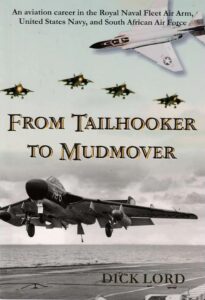
Subtitle: Information not available
Summary: Photorealistic pencil drawings by the author with his own poetry. The book is a poignant exploration of the human experience of South Africans at war in the Rhodesian, SWA and Angolan bush.
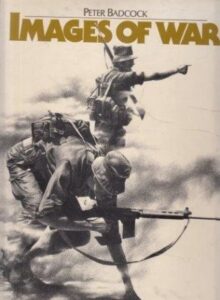
Subtitle: South Africa's Seaborne Raiders 1978-1988
Summary: This seminal work documents the clandestine sea borne operations undertaken by South Africa’s 4 Reconnaissance Commando Regiment. It breathtakingly reveals the versatility and effectiveness of this elite unit which worked with a range of other South African and Rhodesian forces, including the Rhodesian SAS, to engage in a range of raiding and war fighting activities. These operations saw the clandestine reconnaissance of harbors, the sinking of enemy shipping and the destruction of shore installations in Angola and Mozambique. Just some of the tasks undertaken by this extraordinary maritime capability which totaled no more than 45 operators, both black and white! With unparalleled access to previously secret material, the authors, both of whom worked to develop 4 Recce’s operating capabilities, trace the origins of the Regiment back to the 1970’s when the South African’s determined the need for a maritime force projection capability. They relate how maritime doctrine was developed within South Africa’s wider Special Forces capability and how joint operational approaches were configured with the South African Navy. This saw the development of a range of swimmer, reconnaissance, diving and boat operator training courses, along with the design of specialist raiding craft and amphibious assault platforms, which were originated to operate from the Navy’s existing shipping and submarines. All of which demonstrated the immense potential of this newly emergent force and the resourcefulness of its individual operators. Required to successfully complete a grueling selection process, the operators of 4 Recce were relentlessly tested to prove their physical and mental mettle, not to mention their leadership skills and initiative. Steyn and Söderlund’s chronological analysis of the operations undertaken by 4 Recce and the South African Navy is stunning to behold. They impartially detail the secret and specialized actions which saw both success and failure. From Cabinda on the West Coast to Tanzania on the East, 4 Recce, and whose existence and capability was largely kept secret even within the South African Defence Force, conducted numerous clandestine raids. They attacked shipping and strategic targets such as oil facilities, transport infrastructure and even ANC offices. And sometimes the raids did go wrong, spectacularly so in one instance when two operators were killed and Captain Wynand Du Toit was captured. He was later paraded in front of the world’s media, much to the embarrassment of the South African government. This is a fascinating work and one that will enthrall anyone with an interest in Special Forces operations. Profusely illustrated with many previously unpublished photographs, it stands as a testament to the author’s endeavors as, respectively, the former Operations Commander of 4 Recce and the former Commander Task Group of the SA Navy - as well as the incredible operators of 4 Recce. Explosive and compulsive, Iron Fist from the Sea takes you right to the raging surf; to the adrenaline and fear that is sea borne raiding...

Subtitle: Small Team Missions Behind Enemy Lines
Summary: A gripping first-hand account of the combat operations and life of a member of the secretive and elite South African Special Forces, known as ‘Recces’. South African Special Forces, known as the ‘Recces’, are an elite group of soldiers that few can aspire to join. Shrouded in secrecy due to the covert nature of their work, the legendary Recces have long fascinated, but little is known about how they operate. Now one of this select band has written a tell-all book about the extraordinary missions he embarked on and the nail-biting action he experienced in the Border War. Shortly after passing the infamously grueling Special Forces selection course in the early 1980s, Koos Stadler joined the so-called Small Teams group at 5 Reconnaissance Regiment. This sub-unit was made up of two-man teams and was responsible for numerous secret and highly dangerous missions deep behind enemy lines. With only one other team member, Stadler was sent to blow up railway lines and enemy fighter jets in the south of Angola. As he crawled in and out of enemy-infested territory, he stared death in the face many times.
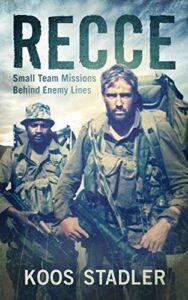
Subtitle: Information not available
Summary: The Selous Scouts were the toughest and most efficient killing machine anywhere in Africa, and its members consisted of the finest guerrilla fighting men in the Western world. Unconventional in many ways, disregardful of parade ground discipline, unorthodox in their dress, yet a force so tightly knit in the face of danger that those who knew anything about them could only marvel.
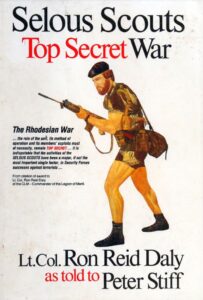
Subtitle: Undeclared War
Summary: In the light of developments in Southern Africa during the last few months of 1978, it has been decided to add two new chapters to the second edition of this book. These are an Introduction, entitled The Third South African War, and a new Chapter 4, entitled What Happened in Rhodesia. Events on the continent of Africa since Mr. Harold MacMillan, then British Prime Minister, delivered his celebrated Wind of Change speech at Cape Town early in February 1960, are quite unintelligible unless seen and understood as part of what has been happening all over the world during the present century. The facts belong together and therefore, have no content of historical meaning when considered separately. In other words, if we wish to understand the present undeclared war on Southern Africa we must first set it in a valid context of history, a task which has been attempted in the first part of this little book. Another global aspect of the struggle is briefly examined in Part I, helping to explain the furious urgency of the pressures now being brought to bear on South Africa, all ostensibly designed to expand the area of freedom and justice, it appears that the continued independence and self-determination of South Africa, the world’s biggest supplier of newly mined gold is seen as the greatest single obstacle to the setting up of a global, totalitarian monetary system, therefore, also as the greatest threat to a tottering monetary system. Part III provides a a concise account of what has been happening in Africa since 1960, with the creation of a form of autonomy and independence which ensures the destruction of the old forms of sovereignty, colonialism, and permits the setting up of new forms of sovereignty so precarious and so artificial that it is an easy matter to dominate them, the words of Dr. Franco Nogueira. former Foreign Minister of Portugal. In this part, also, we see how, like two hoodlums working in partnership, the capitalist West promotes policies in Africa which operate almost always to the advantage of Soviet Communist imperialism. The main battle, however, unsuspected by millions of people, especially in the Western world, is fought inside their own minds as the motives of a tiny minority of power wielders are translated, by the magic of the media, into some semblance of the will of mankind. How the battle is fought, or, rather how the assault on the public mind is conducted, is briefly explained in Chapter 5, which is a summary of two papers accepted for distribution at two recent conferences of the World Anti-Communist League. By challenging, the establishment version of contemporary history, this book offers, at least, a starting point for the few who insist on having opinions which they have some right to call their own.
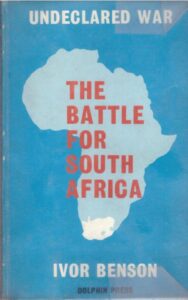
Subtitle: Fighter pilot memoirs & accounts of Cuban, SAAF and Angolan air combat in Southern African skies
Summary: Most books on the Angolan Bush War, especially those in English, present the South African perspective of events. Now a former MiG-23 Squadron Commander of the Cuban Air Force has collaborated with an ex-SAAF pilot to paint a remarkable new picture of the aerial conflict over Angola in the 1980s. In The MiG Diaries the recollections of Lt-Col Eduardo González Sarría are blended by Lionel Reid with those of air combatants from the Angolan, Cuban and South African air forces. Many are being published for the first time. Using their own aviation knowledge and experience of the conflict, Sarría and Reid combine the accounts of these diverse combatants – former comrades and foe – to provide original insights into, and a more holistic description of, what happened in the skies over Angola. The results, often quite different to what the opposing sides had believed, reveal a surprising, and more complete, picture of events. The wonderful sketching pencil of Sean Thackwray, himself a former fighter pilot, helps to bring this unique story to life, along with select images, including many not seen in print in South Africa.

Subtitle: Information not available
Summary: This title is an explosive novel set in the highly volatile area of Senga on the North-Eastern border of Rhodesia (now Zimbabwe) in the mid 1960s and early 1970s. The powerful drama erupts as the British South Africa Police, later joined by the Rhodesian Army and supported by the Air Force, struggle against communist backed guerrillas who use violence and torture to intimidate tribesmen to follow their cause. They fight to restore peace - a peace that is governed as much by force of arms as by the tribesmens' faith in the uncanny predictions of their tribal spirit medium who communes with the spirit of the rain goddess.
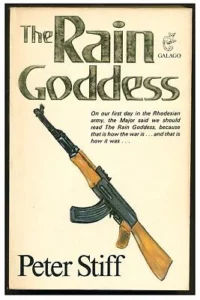
Subtitle: Twelve Months that Transformed a Continent
Summary: The story of the Cuban-South African war in Angola in 1987–88 through the eyes of the South Africans who fought in it. The Angolan Civil War lasted over a quarter of a century, from 1975 to 2002. Beginning as a power struggle between two former liberation movements, the MPLA and UNITA, it became a Cold War struggle with involvement from the Soviet Union, Cuba, South Africa and the USA. This book examines the height of the Cuban-South African fighting in Angola in 1987–88, when 3,000 South African soldiers and about 8,000 UNITA guerrilla fighters fought in alliance against the Cubans and the armed forces of the Marxist MPLA government, a force of over 50,000 men. Bridgland pieced together the course of the war, fought in one of the world’s most remote and wild terrains, by interviewing the South Africans who fought it, and many of their accounts are woven into the narrative. This classic account of a Cold War struggle and its momentous consequences for the participants and across the continent, is released in a new edition with a new preface and epilogue. Table of Contents Preface Prologue PART 1: GENERAL SHAGANOVITCH’S OFFENSIVE The Prelude The South Africans move in Sniffing out the enemy Fapla’s advance continues PART 2: THE DEFENCE South Africa steps things up South Africa’s first disaster Enter the Falcon The first land battle The Second ‘Rumble on the Lomba’ PART 3: THE STING Waiting and watching Recce hardships The Air Force gears up War in the air Laying the trap Fancy tricks and dirty tricks The Cavalry – 61 Mech – rides to the rescue Softening up 47 Brigade The trap closes The destruction of 47 Brigade Booty from the battlefield Fapla’s offensive ends PART 4: THE STALEMATE Forward beyond the Lomba The reinforcements arrive PART 5: THE COUNTER-OFFENSIVE The attack on 16 Brigade ‘Destroy the G-5S!’ Fapla’s Great Escape: The Chambinga Gallop PART 6: THE SIDESHOW Begging for permission to destroy the enemy PART 7: INTO 1988. OPERATION HOOPER – THE COUNTER-OFFENSIVE CONTINUED The attack on 21 Brigade: 13 January 1988 Throwing something at the Cuito River Bridge The attack on 59 Brigade: 14 February 1988 The attack on Highpoint 1251 PART 8: THE SIDESHOW (CONTINUED) The attack on Menongue PART 9: THE THREE BATTLES FOR THE TUMPO TRIANGLE Mike Muller leads the First Tumpo Attack: 25 February 1988 Mike Muller leads the Second Tumpo Attack: 29 February 1988 Jaw-jaw begins to supplant war-war Gerhard Louw leads the Third Tumpo Attack: 23 March 1988 PART 10: THE DENOUEMENT More jaw-jaw Fidel’s last hurrah! Epilogue Postscript: UNITA Timeline Glossary Select Bibliography
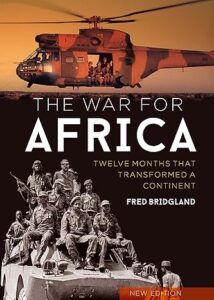
Subtitle: The Story of the Mirage F1 in the South African Air Force
Summary: The original Vlamgat book has all but been sold out and the publisher no longer longer exists. As there was still a strong demand for the book, the author got together with Combat360 Productions and decided to release an update as an electronic ebook.
- The Vlamgat 2005 e-book (Actually the book in .pdf Acrobat Reader format)
- Additional colour photographs
- Audio introduction by the author (The author reading the written introduction)
- Additional previously unreleased material by the author
- History of the Mirage F1 in the SAAF
- Over 90 extra pages written by General Rafael de Pino, commander of the Cuban Air Force in Angola during the conflict about the (early) days in Angola.
- Cuban pilot lists
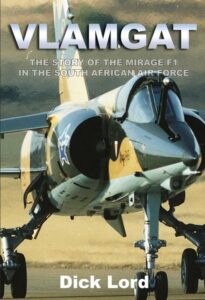
Subtitle: Angolan and Cuban Forces, 1976-1983
Summary: As of mid-1976, the civil war in Angola was seemingly decided: supported by a large contingent of Cuban forces, the MPLA established itself in power in Luanda. Its native competitors, the US-French-Zaire-supported FNLA, and UNITA, supported by China and South Africa, were in tatters. The French and Zaire-supported FLEC – an armed movement for the independence of the oil-rich Cabinda enclave – was in disarray. The last few of their surviving units were either driven out of the country, or forced into hiding in isolated corners of northern and southeastern Angola. Nevertheless, the war went on. The MPLA’s government failed to decisively defeat UNITA, in southern Angola, and then found itself facing a coup attempt from within in May 1977. Crushed in blood, this resulted in thousands being jailed and tortured: many more escaped abroad, where they reinforced the ranks of the battered opposition. The coup prompted the Soviets to attempt increasing their influence with the aim of establishing permanent military bases in the country. While all such overtures were turned down, Angolan operations along the border to what was then the South-West Africa (subsequently Namibia) in October 1980, combined with the increased activity of SWAPO – an insurgency against the South African control of that territory - subsequently Namibia – prompted South Africa to launch another military intervention and resume supporting UNITA. In turn, this prompted not only the Cubans to further increase their military presence, but also the Soviet Union into delivering massive amounts of military aid to the government in Luanda. Angola not only assumed the role of one of the major hot battlefields in the Cold War: its ‘civil war’ saw a number of major showdowns between diverse belligerents, culminating in the Battle of Cangamba in 1983. Based on extensive research, with help of Angolan and Cuban sources, War of Intervention in Angola, Volume 2 traces the military build-up of the Cuban and Soviet-supported Angolan military, the FAPLA and its combat operations, and those of the Cuban military in Angola, in the period 1976-1983, their capabilities and intentions, and their battlefield performances. The volume is illustrated with over 100 rare photographs, half a dozen maps and 18 color profiles.
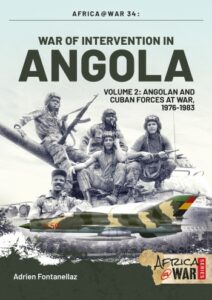
Subtitle: Up Close and Personal in Third World Conflicts
Summary: Venter's choice of military events is eclectic. He has four chapters on Afghanistan, three on Somalia, several on how Lisbon fought its desperate rearguard colonial wars in Angola, Mozambique and Portuguese Guinea as well as several on the Rhodesian War. These include a tribute to his old friend Ron Reid-Daly, founder-commander of the Selous Scouts, a vivid profile of the RLI 'Incredibles' in a cross-border strike on enemy positions in Mozambique as well as a chapter by Colonel Brian Robinson, longest serving commander of the Rhodesian SAS. Venter also draws heavily on his experiences as a military correspondent for Britain's Jane's Information Group in the Middle East: he accompanied the IDF when it went into Beirut in 1982. Neall Ellis who flew helicopter gunships against the rebels in Sierra Leone and is currently flying support missions in Russian Mi-8s in Afghanistan, Al Venter going into combat with a bunch of South African 'Parabats' in a strike against enemy positions in Angola (where he was subsequently wounded), Mike Hoare's aborted invasion of the Seychelles a quarter of a century ago, an American mercenary in Iraq as well as a United States Navy rescue mission in Somalia are among more than 30 chapters that appear in this new book. The book is illustrated with more than 100 photographs and follows the publication of his earlier military titles War Dog (2006) and Barrel of a Gun (2010), both published by Casemate in the US and Britain.
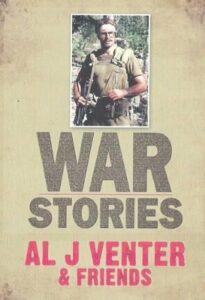
Subtitle: To Hell and Back with Koevoet
Summary: ‘Both my guns are jammed. I’m dead meat, a sitting duck. All the insurgent has to do is pull the trigger of his RPG-7 rocket launcher. My heart surges, pumping pure adrenalin through my body and my mind.’ Arn Durand was a member of Koevoet, the most deadly fighting force involved in the Border War. Their task was to seek and destroy SWAPO PLAN insurgents. Zulu Zulu Foxtrot is an explosive account of Durand’s time with Koevoet during the mid-1980s, during which he went deeper into Angola than before. The book takes the reader on patrols through the bush and into ambushes and contacts with the enemy, which are described in nerve-shattering detail. Written in the same gripping, novelistic style as Durand’s previous book, Zulu Zulu Foxtrot recreates the experience of being in the heat of battle and delves more deeply into the psyche of the modern warrior. This is the explosive follow-up to Zulu Zulu Golf, covering Arn Durand's next few years in Koevoet, the most deadly fighting force involved in the Border War. After moving to the unit Zulu Foxtrot, Durand went deeper into Angola than before and was involved in more contacts with the enemy, which he describes in nerve-shattering detail. Balancing the action is a dramatic human story, as Durand faces the tragic death of his commander, Frans Conradie, one of the pioneers of Koevoet, who had become a mentor to him.
